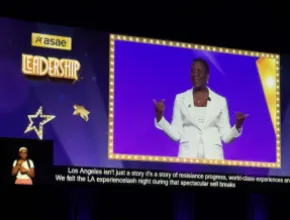Mention networking these days on your live event agenda and you may be met with eye rolls—or total rejection—from delegates.
Younger attendees may regard their social media connections as the only linkups they need. Others just want to avoid empty, backslapping cocktail chat that brings them little more than a pocketful of business cards. Yet if you ask most any group of attendees and vendors why they are attending your live event, most will say they want to find their "tribe" of people to engage in a productive business exchange.
Face-to-face events remain the place where people look each other in their eyes, press the flesh, and begin and nurture relationships. Sure, digital touches can support the process, but they rarely yield desirable outcomes all on their own.
Though some planners are calling the process of starting and building effective relationships connecting, connexity or NetWORTHing (a registered term by Velvet Chainsaw Consulting), all of these words describe the age-old process of starting and building business relationships.
Whatever they call it, planners who are focused on helping attendees find their matches are rejecting the idea they will just happen. They're designing intentional encounters.
Why Intentional Design
Today's business people are distracted by their mobile devices and a thousand other things that can overtake your live event agenda. Cultural and demographic diversity can also provide challenges to a productive culture of connectivity.
"Typically, we gravitate toward people who are just like us," says Shawna Suckow, CMP, an industry speaker and founder of SPIN (Senior Planners Industry Network). "So intentional design can help people meet others who aren't like them because they don't do that naturally."
Good networking design can also bring introverts and others huddled in their corners, heads down to their mobile devices, out of their shells. "Technology has gotten in the way of our networking efforts," Suckow adds, "and attention spans have gotten much shorter. So unless we really put forth the effort, good connecting is not going to happen."
Taking at least some control of the connecting process with intentional design can make a major difference in your event's success as perceived by attendees, say the experts.
What Networking Is Not
Sarah Michel, vice president of Velvet Chainsaw Consulting, says almost everyone has been a victim of network drive-by at a live conference.
"It's when you get violated by someone who only talks to you if they think you can do something for them," Michel says. "The whole time they've got one eye searching for more influential target to move to. Everyone has been burned by someone who in the name of networking, was only pursuing their own selfish agenda. These are people who have made networking a dirty word."
Finding people online can start a relationship, says Susan RoAne, speaker and author of How to Work a Room, but something else has to happen that happens only in a face-to-face setting.
"People who think their 500 friends on Facebook are reliable relationships are often deluded," RoAne says. "I would ask them how many of those faces can they call in the middle of the night, or how many are really there for them for some business favor."
Encouraging Good Connectivity
Those practiced in the art of fostering live event connections recommend doing whatever possible to encourage behaviors that flow from old-school social graces.
"Hosting a live meeting is like hosting people in your home," RoAne says. "You plan the details, logistics, and then work to make people feel at home and relaxed. I tell people to always act like a host whether they are or not. If this is your mindset, you are focused on others and their needs."
Giving people adequate time on the schedule to interact is important, too, she contends.
"If your meeting is packed with only 15-minute breaks, most women won't even get to the bathroom, much less do quality interactions. Don't tell attendees to talk with each other and then not give them time to do it."
Suckow believes those whose mindsets are on what they can do for others are in the right mode.
"I have a good friend in the industry who will not talk about himself or his services until he has helped someone," she says. "His first question to someone he's just met is about how he can be of service to them. He understands that this comes first in building a relationship."
People who are measuring the success of networking by the number of leads they collect are measuring networking all wrong, she stresses. People are not leads, they're human beings.






